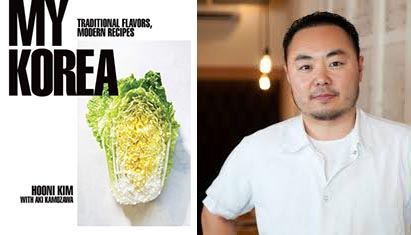단지(Danji) 셰프 후니 김 요리책 'My Korea' 출간
My Korea: Traditional Flavors, Modern Recipes
by Hooni Kim

An Epicurious Spring 2020 "Book We Want to Cook from Now"
An Eater Best Cookbook of Spring 2020
A Michelin-starred chef known for defining Korean food in America brings a powerful culinary legacy into your kitchen.
Simple rice cakes drenched in a spicy sauce. Bulgogi sliders. A scallion pancake (pajeon) the New York Times calls “the essential taste of Korean cuisine.” For years Hooni Kim’s food has earned him raves, including a Michelin Star—the first ever awarded to a Korean restaurant—for Danji. His background in world-class French and Japanese kitchens seamlessly combines with his knowledge of the techniques of traditional Korean cuisine to create uniquely flavorful dishes.
My Korea, his long-awaited debut cookbook, introduces home cooks to the Korean culinary trinity: doenjang, ganjang, and gochujang (fermented soybean paste, soy sauce, and fermented red chili paste). These key ingredients add a savory depth and flavor to the 90 recipes that follow, from banchan to robust stews. His kimchis call upon the best ingredients and balance a meal with a salty, sour, and spicy kick. Elevated classics include one-bowl meals like Dolsot Bibimbap (Sizzling-Hot Stone Bowl Bibimbap), Haemul Sundubu Jjigae (Spicy Soft Tofu Stew with Seafood), and Mul Naengmyeon (Buckwheat Noodles in Chilled Broth). Dishes meant for sharing pair well with soju or makgeolli, an unfiltered rice beer, and include Budae Jjigae (Spicy DMZ Stew) and Fried Chicken Wings.
Complete with thoughtful notes on techniques and sourcing and gorgeous photography from across Korea, this cookbook will be an essential resource for home cooks, a celebration of the deliciousness of Korean food by a master chef.
Editorial Reviews
In this exciting debut, Kim, chef at Michelin-starred New York City restaurant Danji, collects Korean recipes that are in turn spicy, funky, and comforting. Chapters follow the progression of a Korean meal, beginning with banchan, the small dishes that appear at the start, including homemade silken tofu and dried anchovies fried until crisp and tossed in a sweet, sticky sauce. Kim skillfully describes Korean food culture: in Korea, anchovy broth, “a hangover remedy,” is served in late-night tent-taverns, and Spam is specially packaged for holiday gift giving (Kim shares recipes for the broth with somen noodles, and for a spicy stew made with Spam). Kim isn’t wedded to tradition, but when he does craft variations, they’re on target, as when brisket stands in for the pork in fried rice or bacon and kimchi marry in a savory sauce. The chapter dedicated to kimchi contains a traditional cabbage recipe as well as versions made from ramps or radishes. Meat dishes include pork belly sliders and Hanjan chicken skewers, and seafood choices, such as black cod simmered in an umami-rich sauce, appear as well. A chapter on cocktails includes a colada made with probiotic yakult and rum, and a handful of desserts feature shaved ice. This thoughtful, comprehensive, and inventive volume sets a high bar for Korean cookbooks. (Apr.) -Publishers Weekly-
"A passionate, personal story of an immigrant’s sense of identity and belonging through food. Every page is vibrant and inspirational, and you’ll want to eat and cook every recipe. -Anita Lo-
"Finally, a true Korean cookbook filled with recipes that are unapologetically traditional and incredibly well researched. Hooni Kim is not just an amazing chef—he is someone who is creating an essential archive of Korean food for generations to come. If you want to know about Korean cuisine, this is the book to own!" -Edward Lee-





